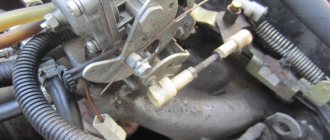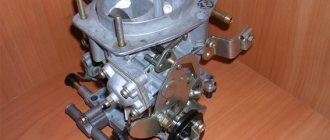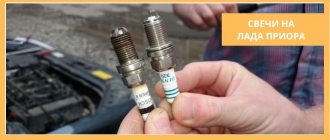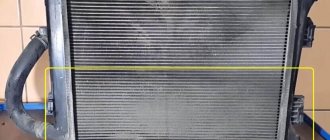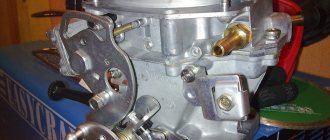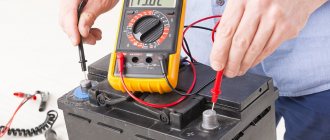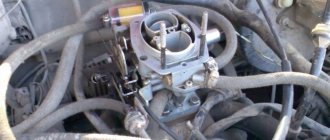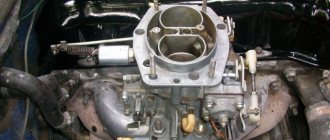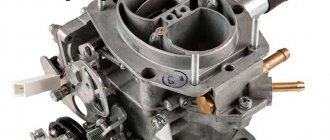The carburetor on the V8 ensures acceptable fuel consumption both in city mode and when traveling on the highway. Solex 21083 is one of the best and most reliable domestic devices of this kind. Making changes to its design can help improve dynamic performance or reduce gasoline consumption. The question arises, which jets should be replaced to achieve the desired effect?
To get the answer, you will need to understand the principle of operation of the device. The main task of the carburetor is to create a lean air-fuel mixture. To achieve this, the designers were forced to install fuel jets with a small flow area on the carburetor. The air channels have calibrated holes opposite the increased diameter. As operating practice shows, engine operation in this case remains stable even with sudden changes in modes.
Solex carburetor 21083 jets: types and selection
Solex 21083 carburetor jets are presented in two types: fuel and air.
Air and fuel jets have opposite effects on the composition and quality of the combustible mixture. In the process of increasing the cross-sectional area of the fuel nozzle, an enrichment of the combustible mixture will be observed, and in the case of an air nozzle, a depletion will occur.
It should be taken into account that the degree of their influence is not the same under different operating modes of the Solex 21083 carburetor. If you change the cross-section of the main jet, the composition of the fuel mixture will begin to change in direct proportion for all throttling modes from low loads to full throttle opening.
Also, the effect of the air jet is felt more in the process of increasing the opening angle of the throttle valve.
Thus, if it is necessary to change the composition of the fuel mixture over the entire range of characteristics, then it will be necessary to change the performance of the fuel main jet. To change the characteristics of the combustible mixture composition curve, it is necessary to use an air jet.
From the shown economic characteristics of a car with different performance of the air and fuel jets of the main carburetor system, it follows that if the performance of the fuel main jet increases, fuel consumption will correspondingly increase at all speed modes of the car.
Changing the performance of the air jet allows you to increase fuel consumption only at high speeds of the car. When selecting the most suitable performance of the air and fuel jets, it is important to select the optimal composition of the supplied fuel mixture for a certain operating mode of the car engine.
The correct choice of the necessary characteristics of the metering main system will further determine the smoothness and stability of the engine, this will be especially noticeable at partial loads. While driving around the city, 65% of the time the car operates with the throttle valve slightly closed at the moment the intake pipeline is discharged above 450 mmHg, and also consumes up to 35% of the total amount of fuel.
Results
Of course, it is clear that there is no limit to improvements. Sometimes they can even go to excess: drilling, for example, a throttle valve, polishing an MD, soldering epulsion tubes on a carburetor. But, as they say, what is in excess is unhealthy. But such a procedure, fascinating in its own way, like selecting the types of jets for a Solex 21073 carburetor, for example, is something quite necessary for the correct setup of the unit and its complete compatibility with the engine compartment. As a result, you get an economical car that responds well to gas.
Table of fuel jets for Solex carburetor 21083
During the process of carburetor throttling, one can observe an unstable composition of the fuel mixture over time in the working charges; there is no cycle identity. This has a significant impact on the composition of exhaust gases. Also, the heterogeneous composition of the combustible mixture over cycles can be affected by three factors:
The type of flow of the emulsion mixture from the channel of the main spray system can have a significant impact on the flow structure. Depending on the ratio of the productivity in the dosing jet system and the flow rate of the emulsion, the following types of flow can be obtained: laminar, plug, coarse emulsion, axisymmetric and wave.
Thus, depending on the change in the type of flow from the nozzle of the main emulsion system, the homogeneity of the composition of the fuel mixture in the operating cycles of the car engine will change significantly. The axisymmetric mode is the most optimal for stable operation of the car engine. This can be achieved thanks to a uniform fuel supply.
The air jets of the Solex 21083 carburetor allow you to adjust, together with the fuel jets, the optimal operation of the carburetor. It should be remembered that the location of the air jet of the main system inside the fuel-air main path is undesirable due to the possibility of clogging or tarring of the jet, which can lead to carburetor malfunctions.
This is often observed when engine crankcase gases pass through the carburetor. It is best to place the air jets in special pockets that will protect them from the effects of direct air flow.
In case of modification or tuning of the Solex 21083 carburetor, it is necessary to pay due attention to the selection of jets. This process should be carried out depending on the volume of the car’s engine. Thus, for large engine volumes, for example 1.5-1.7, it is best to use small jets.
Due to the large volume, a lot of air will pass through the diffuser per unit of time, and as a result, significantly more fuel will be consumed. Of course, if you are not going to pump up your car for fast driving, then this will not be so significant for you. Otherwise, it is better to install jets with a smaller cross-section.
It is best to start selecting a jet with a fuel jet, and then move on to choosing an air jet. It should also be noted that you first need to select jets for the first chamber, and after installing the jets on it, you should move on to the second chamber of the carburetor. This is the only way to consider the most correct installation or replacement of jets.
Qualified specialists advise that before starting work, find the original factory Solex 21083 carburetor, which is designed for the same engine size as that installed on your car, and try installing these jets on it. Below is a table of jets for the Solex 21083 carburetor.
Depending on your preferred driving style, you can choose the most optimal jet size for yourself. But keep in mind that when using sport series jets, the fuel consumption of your car can double.
Therefore, if you prefer optimal fuel consumption and a dynamic car, then it is better to choose the middle option, for example “normal power” or “moderate power”. For those who prefer a measured, calm driving style, “economical” jets are best suited. By the way, there is also another modification: Solex carburetor 21083 1107010, it has its advantages.
And the video shows how to choose the right jets for the Solex 21083 carburetor:
Source
Replacement in every detail
Having selected the Solex carburetor jets by numbers, you can begin to replace them; unlike boring, it is quite possible to carry out this operation yourself at home. By the way, the reason is not always an incorrectly selected element; very often during operation, these parts wear out and become clogged, which leads to a change in the diameter and composition of the mixture with all the ensuing consequences. In addition, car owners in this way increase the power of their “iron horse” or, conversely, reduce gasoline consumption. In general, replacing jets is quite suitable in the category of vehicle tuning.
Solex carburetor jets
Carburetors of the Solex family have almost the same design (body, cover). But they have different jets (with different performance), since they are used on engines of different sizes. Let's compare the performance of fuel and air jets of the main carburetor systems of the Solex family. This information can help when checking whether the markings of the jets installed on a particular carburetor correspond to the nominal value or when setting the carburetor to an economical operating mode by selecting jets or a more powerful mode.
Solex carburetor jets, applicability table
Fuel jets GDS carburetors Solex
| Carburetor models | 1st camera | 2nd camera |
| 2108-1107010 | 97,5 | 97,5 |
| 21081-1107010 | 95 | 97,5 |
| 21083-1107010 | 95 | 97,5 |
| 21073-1107010 | 107,5 | 117,5 |
| 21051-1107010 | 105 | 110 |
| 21083-1107010-31 | 95 | 100 |
| 21083-1107010-35 | 95 | 100 |
| 21083-1107010-62 | 80 | 100 |
| 21412 | 95 | 95 |
Location on carburetor
Fuel jet GDS of the first chamber of the Solex 21083 carburetor
Air jets GDS carburetors Solex
| Carburetor models | 1st camera | 2nd camera |
| 2108-1107010 | 165 | 125 |
| 21081-1107010 | 165 | 135 |
| 21083-1107010 | 155 | 125 |
| 21073-1107010 | 150 | 135 |
| 21051-1107010 | 150 | 135 |
| 21083-1107010-31 | 155 | 125 |
| 21083-1107010-35 | 150 | 125 |
| 21083-1107010-62 | 165 | 125 |
| 21412 | 160 | 100 |
Location on carburetor
Details of the MDS (main metering systems) of the Solex 21083 carburetor
Fuel jets for the idle system of Solex carburetors
| Carburetor models | 1st camera | 2nd camera |
| 2108-1107010 | 39-44 | — |
| 21081-1107010 | 39-44 | — |
| 21083-1107010 | 39-44 | — |
| 21073-1107010 | 39-44 | — |
| 21051-1107010 | 37-43 | — |
| 21083-1107010-31 | 38-44 | — |
| 21083-1107010-35 | 38-44 | — |
| 21083-1107010-62 | 50 | — |
| 21412 | 35-41 | — |
Location on carburetor
Electromagnetic valve EPHH of a Solex carburetor with fuel jet CXX
Air jets for the idle system of Solex carburetors
| Carburetor models | 1st camera | 2nd camera |
| 2108-1107010 | 170 | — |
| 21081-1107010 | 170 | — |
| 21083-1107010 | 170 | — |
| 21073-1107010 | 140 | — |
| 21051-1107010 | 140 | — |
| 21083-1107010-31 | 170 | — |
| 21083-1107010-35 | 170 | — |
| 21083-1107010-62 | 160 | — |
| 21412 | 150 | — |
Location on carburetor
Visible elements of the CXX carburetor 2108, 21081, 21083 Solex with the cover removed
Fuel jet of the transition system of the 2nd chamber of the Solex carburetor
| Carburetor models | 1st camera | 2nd camera |
| 2108-1107010 | — | 50 |
| 21081-1107010 | — | 50 |
| 21083-1107010 | — | 50 |
| 21073-1107010 | — | 70 |
| 21051-1107010 | — | 50 |
| 21083-1107010-31 | — | 50 |
| 21083-1107010-35 | — | 80 |
| 21083-1107010-62 | — | 50 |
| 21412 | — | 80 |
Location on carburetor
Fuel nozzle of the transition system of the second chamber of the Solex 2108, 21081, 21083 carburetor, installed in the fuel intake tube
Air jet of the transition system of the 2nd chamber of the Solex carburetor
| Carburetor models | 1st camera | 2nd camera |
| 2108-1107010 | — | 120 |
| 21081-1107010 | — | 120 |
| 21083-1107010 | — | 120 |
| 21073-1107010 | — | 140 |
| 21051-1107010 | — | 150 |
| 21083-1107010-31 | — | 120 |
| 21083-1107010-35 | — | 150 |
| 21083-1107010-62 | — | 120 |
| 21412 | — | 150 |
Location on carburetor
Air jet of the transition system of the second chamber of the Solex carburetor
Fuel jet for GDS carburetor actuator 21083-1107010-62 Solex
Notes and additions
— Solex carburetor jets are interchangeable. That is, you can install jets from another Solex carburetor on your carburetor without any problems, but, for example, with higher or lower performance.
— The transition system of the first chamber of the carburetor does not have its own jets; it is structurally combined with the carburetor idle system.
— The fuel and air jets of the gas pumping system, the fuel jet of the idle system can be unscrewed and replaced, the rest cannot.
More articles on the Solex carburetor
Solex carburetor jets:
Try installing the air jet GDS 150 (from 21073) instead of the original 155 and the fuel jet GDS 97.5 (from Solex 2108) instead of the original 95 into the first chamber. You don’t have to touch the second chamber. The rest of the jets can also be left untouched. If engine thrust has improved, you can install even larger jets. But, in general, it is better to put back the Solex 21073 since its main difference from the 21083 is the increased size of the large diffusers. Since there is a dependence - the larger the engine volume, the larger the carburetor diffusers. To adjust 21083 to 21073, you need to bore the diffusers, which is problematic and does not always help.
Hello. There is an 83 carburetor on the field. What can be changed so that it is close to 73 engine 1.7
Hello. You are configured to slightly enrich the fuel mixture in the first chamber and a little more in the second chamber. I would leave everything as is. Of course, if you need to reduce fuel consumption, you can put a 155 air jet in the first chamber, as is standard for Solex 21083 and 2108. And in the second chamber - a 100 fuel jet from Solex with automatic suction.
Hello. 21083 now there are jets 97.5/155 and 102.5/125 Corolla 1.3 cam 7, sprayer 35/40 in both chambers. Should I switch to a standard jet base? And tell me which ones to install then, and the type. Thank you
One spray nozzle is a modification of the accelerator pump only to improve throttle response and quick start. You don’t have to touch the GDS jets at all, as well as the gap at the second throttle valve. That is, limit ourselves to only this modification. If desired, you can increase the fuel jet of the first chamber by 2.5 (was 95 now 97.5), without touching the air jet. This is to enhance the effect of finalizing the UN.
Which jets 21081 with one nozzle No. 40 should be installed in the 1st chamber, and then what is the flap clearance in the second chamber?
Source
Tuning Solex and its feasibility
There is no need to immediately begin drastic measures to modify the carburetor - it will be enough to perform the simplest operations, and the characteristics of the Solex can be changed beyond recognition and congenital diseases can be eliminated. Minimum things to do:
- selection and replacement of fuel jets;
- selection and replacement of air jets;
- changing the size of the primary chamber diffuser;
- polishing and grinding of small diffusers;
- adjustment and polishing of throttle valve axles.
Solex carburetor 21083: device, adjustment, configuration
For a long time, front-wheel drive VAZ 2108-09-099 cars were equipped with carburetor engines, and only closer to the beginning of the 2000s, a fuel injection system began to be installed on VAZ cars.
This article will discuss the Solex 21083 carburetor: device, adjustment, configuration of the unit, its features, as well as main malfunctions.
Solex 21083 carburetor design
Solex-type carburetors began to be used on Russian (Soviet) cars from the mid-80s of the last century; at first they were installed on the VAZ-2108 car. The first carburetors were designed to work with engines of 1100 and 1300 cm³, and they were labeled DAAZ-2108. Later, the Solex 21083 model was developed, and the digital index means that the device is intended for installation on 1.5-liter VAZ-21083 engines.
The carburetor serves to prepare the fuel mixture on which the engine runs and ensures uninterrupted, stable operation of the power unit at any speed and load. Solex-21083 consists of the following main parts:
The Solex carburetor is a two-chamber carburetor, the GDS fuel jets are located in the middle of the chambers in the very depths of the main body, and the GDS air jets are installed on top of them. The Solex 21083 carburetor is equipped with a heating unit for the air-fuel mixture, to which the cooling system hoses are connected. The throttle valves are located at the bottom of the main body and open sequentially; the opening of the valve in the second chamber is ensured by the drive levers.
There are two pipes in the cover - one of them is designed to supply fuel to the carburetor, the second is a return pipe and serves to return excess fuel to the gas tank; also, due to the “return”, the pressure in the fuel system is reduced.
Solex 21083 carburetor: jets, types and selection
For 21083 carburetors, the industry provides repair kits that include fuel and air jets for the primary and secondary chambers. Depending on the size of the diffuser cross-section, there are different repair kits designed to work with engines 2108, 21081 or 21083, so the jets in the kits have different cross-sections.
Often VAZ carburetors are installed on other brands of cars (for example, UAZ, Volga GAZ-31029/3110), and if you leave the “original” GDS jets, their cross-section will not be enough, since the air-fuel mixture will enter the cylinders in the wrong proportion and the quantity required by the engine.
Often, to improve the acceleration and dynamics of the car, some motorists install fuel nozzles with a larger cross-section, but it should be borne in mind that in this case, fuel consumption may increase significantly, and experimenting with the installation does not always give the desired results. The most correct decision is not to engage in experiments, and install in the carburetor the repair kit that is intended specifically for this brand of carburetor (for example, for a 1.5 liter engine, you should install jets designed for model 21083).
If the engine dynamics are not satisfactory, you should look for the reasons for the sluggish acceleration of the car, and there can be quite a lot of them:
There are many more different reasons due to which engine power is lost. Car owners have different opinions about carburetor tuning, but practice still shows that it is better to install the carburetor recommended by the manufacturer on the car.
At one time, in order to save fuel on a GAZ-31029 or 3110, the owners of these cars often installed VAZ Solexes, but such an installation generally did not justify itself - even if it was possible to save gasoline, it was only with very careful driving and weak acceleration. So the jets in the Solex 21083 carburetor should be those recommended by the manufacturer. It should also be taken into account that many repair kits are now sold for the VAZ Solex from different manufacturers, including parts produced by China. In such kits, the cross-section of the jets may not correspond to the declared parameters, so you should try to purchase parts from original production or at least from trusted companies that have proven themselves in the market.
What are the jets responsible for?
This is the name given to carburetor parts that have calibration holes for dosing fuel or air. As you may have guessed, depending on their purpose, jets are divided into fuel and air. These elements have opposite effects and have different effects on the composition of the fuel mixture. By increasing the cross-section of the fuel (main) jet, we get a rich mixture, and, on the contrary, a lean mixture of air.
Carburetor parts for fuel metering
From all of the above, it is clear that these parts affect fuel consumption and, naturally, the financial side of car maintenance. As the performance of the main element increases, fuel consumption in all modes will increase. And by changing the air performance, the car will “eat” more only when driving at higher speeds.
Adjusting the Solex 21083 carburetor
The Solex carburetor has several types of adjustments, and you can adjust:
Adjusting the quality of the vehicle is very simple, and any car owner can do the adjustment with his own hands. To do this, you need to warm up the engine well and set the speed screw to 800-900 rpm. Then:
In other cases, you have to loosen the quantity screw more, since dips appear in the engine’s operation.
One of the most common idle problems is the inability to adjust the Solex 21083 carburetor using a quality screw - when it is tightened and unscrewed, the engine speed does not change. There are several reasons for this malfunction:
It’s quite easy to check the functionality of the EC itself; we do it as follows:
It is also necessary to immediately blow out the nozzle - in some cases, such a small speck gets into it that it is practically invisible. There is also a problem with Solex - the idle channel under the quality screw becomes so clogged that it is impossible to clear it.
You can check the performance of the EC in another way - while the internal combustion engine is idling, you need to pull the wire from the solenoid valve - if the engine stalls, it means that the solenoid valve is working properly.
If the XX channels are clogged, the engine starts to work intermittently at minimum speeds and stalls when the gas is released. When you don’t have time to do repairs, but you need to get to your destination urgently, there is one way to make the engine run stably at idle. To do this, while the internal combustion engine is running at idle, we loosen it with a 13 EK key and find the position in which the engine operates most stably. But you shouldn’t drive like this all the time - with this position of the solenoid valve, fuel consumption increases sharply, since the idle system bypasses the XX fuel nozzle.
Fuel level in the Solex 21083 carburetor
In order for the carburetor to work smoothly, it must be adjusted; first of all, the level in the float chamber should be set. To make this adjustment, it is not necessary to remove the entire carburetor; it is enough to remove only the top cover of the unit.
On a VAZ-2109 car we adjust the fuel level as follows:
According to the book instructions, the fuel level in the Solex 21083 carburetor is measured using a caliper - the distance between the upper surface of the main body and the level of fuel in the chamber is determined, it should be 24-26 mm. The measurement should be made immediately after removing the carburetor cap, since gasoline evaporates quickly.
Signs of carburetor malfunction
Signs of a malfunctioning Solex carburetor are:
- inability to start the power unit;
- complicated starting of a cold or hot engine;
- unstable idle;
- idle speed is too high or too low;
- increased gasoline consumption;
- reduction in engine power characteristics;
- jerks and dips when pressing the accelerator pedal sharply.
Let's take a closer look at each of the symptoms in the context of possible malfunctions.
The engine does not start at all or starts but immediately stalls
If a vehicle's engine does not start (with a known-good ignition system), it is possible that fuel is not getting into the cylinders. To check whether it enters the intake manifold, you need to remove the air filter housing and turn the throttle valve drive sector 2-3 times, observing the “spouts” of the sprayer. The fuel from them should spray out in thin but continuous streams. If this does not happen, it is worth checking the operation of the fuel pump, as well as the condition of the carburetor strainer.
It is also possible that the fuel valve needle may jam in the closed position, blocking the flow of gasoline into the float chamber. In order to return the needle to its normal position, it is enough to gently hit the carburetor body with something (for example, a key). In the future, the needle valve will need to be replaced.
If the engine starts and immediately stalls, this may be the result of a lean fuel mixture or a faulty solenoid valve. In the first case, it is necessary to check the intake pipe for leakage of foreign air, and also adjust the quality of the mixture.
To check the solenoid valve in this situation, disconnect the power wire from it, turn on the ignition and touch its contact with the tip of the wire several times. When touched, a characteristic click should be heard, indicating that the electromagnet is triggered. It would not be superfluous to unscrew the valve, inspect and clean its nozzle with a stream of air, and also check the condition of the rubber gasket.
Difficulty starting a cold engine
Typically, problems with starting a cold power unit occur due to incorrect adjustment or malfunction of the starting device. If during start-up the air damper does not completely close the channel, this leads to an excessively lean fuel mixture. At the same time, the engine “grabs” in places, but still stalls. Incomplete opening of the damper, on the contrary, leads to over-enrichment of the combustible mixture, which increases gasoline consumption and may also cause detonation.
This problem is eliminated by adjusting the starting device.
Difficulty starting a warm engine
The main reason for the difficulty of starting the engine “hot” is also the over-enrichment of the mixture. It can be caused by incorrect adjustment of the starting device, as well as an excessively high level of gasoline in the float chamber. In the latter case, fuel is overfilled, which, again, leads to an increase in its consumption.
“Overfilling” is a fairly common phenomenon for Solex. If, looking at the gasket between the carburetor and the cover, you find that it is wet, and there is a persistent smell of gasoline in the engine compartment, there is an “overflow”. It may occur due to:
- incorrect setting of the float mechanism;
- problems with the fuel valve needle (needle sticking in the open position);
- float damage;
- the float hitting the chamber wall.
To eliminate this problem, it is necessary to disassemble the carburetor, check the valve and adjust the float mechanism.
Unstable idle
Normal idle speed of the power unit is one of the main criteria for assessing the performance of the carburetor. Its violation may be caused by:
- contamination of jets and XX channels;
- breakdown of the solenoid valve;
- malfunction of the EPHH control unit;
- damage to the rubber seal (ring) of the fuel quality screw.
Clogged nozzles can be eliminated by washing and purging them. The faulty valve, EPHH block and seal must be replaced.
Idle speed too high or too low
Engine speeds that are too high or too low when idling may result from:
- contamination of the air or fuel nozzle channels;
- suction of excess air;
- improper adjustment of idle speed (quality-quantity);
- too high or low level of gasoline in the float chamber;
- incomplete opening or closing of the air damper.
This malfunction can be eliminated by adjusting the carburetor after cleaning and flushing it.
Increased fuel consumption
The following carburetor malfunctions can lead to excessive fuel consumption:
- malfunction of the storage economizer system;
- incorrect adjustment of the composition of the combustible mixture;
- clogging of air jet channels;
- incomplete opening of the air damper;
- The fuel level in the float chamber is too high.
The problem of increased fuel consumption is solved by diagnosing and adjusting the carburetor.
Reduced engine power
A decrease in the power performance of the power unit is caused by a lean fuel mixture. At the same time, the car takes a long time to accelerate, and when you sharply press the accelerator pedal, the engine “chokes” and short-term dips appear.
The reasons for this phenomenon may be:
- incorrect adjustment of the mixture composition;
- air leak;
- low level of fuel mixture in the float chamber.
Dips, jerks
The occurrence of jerks and dips under engine load occurs due to:
- clogged strainer on the carburetor inlet fitting;
- clogging of the fuel nozzle;
- air leak;
- low fuel level in the float chamber;
- accelerator pump malfunction.
Setting up the Solex 21083 carburetor
All of the above adjustments relate to the settings of the Solex 21083 carburetor, and the nature of engine operation and fuel consumption depend on how well the unit is adjusted. There are some other settings that you should also pay attention to.
The solenoid valve contains an idle jet, and the diameter of its cross-section can be different - from 39 to 42 mm; there are also accelerator pump nozzles with different cross-sections of “spouts” (35x40, 40x40, 45x40, 35x35). By selecting the required diameter of both elements, you can achieve carburetor operation without failures and good throttle response. It is difficult to recommend anything specific here; each specific case requires an individual approach, and the best result is achieved by trial and error. By the way, the “spouts” of the sprayers can be directed:
When installing a carburetor, many motorists often make one mistake - the choke cable is not installed accurately, and therefore it is problematic to start the 21083 engine when cold, especially in frosty weather. After securing the choke cable, before installing the air filter, it is necessary to check whether the air damper is closed completely using the cable. If the damper remains slightly open when the choke is pulled out, it is necessary to secure the cable braid in a different position.
Setting up the float chamber
This type of work allows you to adjust the optimal amount of gasoline in the float chamber. An incorrect level causes a decrease in power, uneven engine operation, and excessive fuel consumption.
Tools:
- set of wrenches;
- thin probe (diameter 1 mm);
- pliers.
1. Remove the air filter and unscrew the carburetor cover.
2. Carefully remove the float chamber cover.
3. Check the condition and position of the floats. They should be parallel to the imprints of the side walls of the float bath on the gasket.
4. If they are displaced, we align them by bringing them together or spreading them apart.
5. Next, lay the lid horizontally with the floats up and use a feeler gauge to measure the distance from the bottom of the float to the gasket. It should be equal to 1 mm. If it is higher or lower, we continue further adjustment after installing the carburetor on the engine.
6. When fuel is pumped into the float chamber, its level should coincide with the red lines, as shown in the photo.
7. If the floats are set incorrectly, this level will be lower or higher. Simple adjustment is carried out by bending or bending the tongue of the floats, then closing the carburetor cover and pumping fuel.
For details on setting up the float chamber, see here
